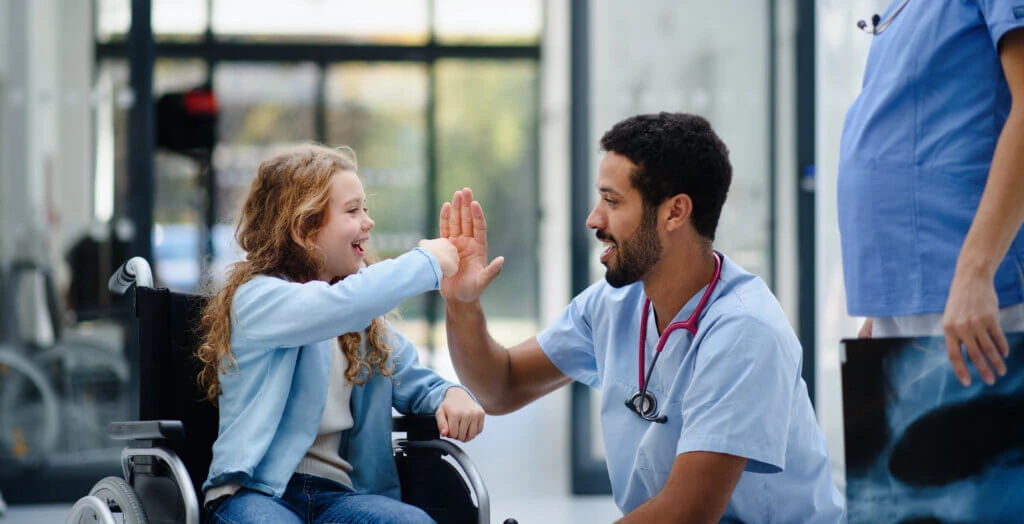
Nurses: The Essential Backbone of Patient Care
EHR-based nurse messaging represents a powerful but often-overlooked opportunity to deliver essential health and Rx information at critical points of care (POCs). Nurses spend significantly more time with patients than physicians do, often filling gaps in communication when physicians are limited to short consultations. As Wolters Kluwer (2024) notes, “If a patient didn’t understand a hurried physician, a nurse can take the time to explain more about their condition by accessing the EHR.”
In 2021, nurses spent 22% of their time navigating EHRs—a percentage likely higher now—time that could be better optimized to support direct patient care (Appl Clin Inform 2021). By tailoring Point of Care media specifically for nurses, including EHR-based messaging, marketers, manufacturers, and healthcare providers can better equip nurses with the resources they need to effectively assist both doctors and patients. As the professionals most trusted and most engaged with patients, nurses are pivotal in ensuring that critical information reaches the right people. Maximizing the value of their time and tools is essential for improving care outcomes.
For over 20 years, nurses have consistently ranked as the most trusted professionals. According to the latest Gallup poll, 78% of people believe nurses are honest and hold high ethical standards, compared to 56% for doctors (Gallup 2024). This deep trust likely stems from the significant time nurses spend with patients across diverse settings, from emergency rooms to home health care. Integrating POC media into EHR systems and across all care channels reinforces this trust by ensuring nurses have access to the most relevant educational tools during moments of patient care.
Nurses don’t just provide care; they triage, diagnose, advise, and manage care lines—all while navigating EHRs. Moreover, nurse practitioners are able to assess, diagnose, treat, and prescribe medications. Customizing POC content for nurses—as both recipients and distributors of educational materials—is crucial for healthcare marketers to make a meaningful impact. While nurses are vital healthcare providers who support physicians, their unique education, workflows, and needs require tailored approaches.
Health technology innovations offer a growing opportunity to invest in POC education and resources that engage the entire care team. Customizing EHR-based messaging for nurses not only enhances their ability to deliver informed, comprehensive care but also strengthens the delivery of relevant, timely information to both care providers and patients. In this article, we’ll explore the potential for POC content, focusing on EHRs as a critical opportunity to unify and strengthen POC initiatives by including the larger care team as key educators and influencers in treatment decisions, adherence, and patient outcomes.

Understanding Nurses’ Interactions with the EHR
Nurses use EHRs throughout the patient care journey, offering natural opportunities to integrate valuable educational materials that enhance care delivery.
The expanding capabilities of EHR systems are opening new pathways for delivering personalized Point of Care (POC) media content. For example, current integrations allow EHRs to print or digitally send medication guides directly to patients, ensuring timely access to crucial information.
Looking ahead (and some companies are already doing this), EHR systems can play a key role in facilitating personalized patient education in ambulatory or hospital settings. Nurses and doctors using the EHR could connect patients and their caregivers to educational content through the system. For instance, EHRs could help trigger access to condition management videos or discharge preparation guides delivered via bedside tablets or television screens. This integration ensures that content remains relevant, tailored to each patient’s language preferences, age, and health literacy.
Here are key touchpoints where POC media could offer critical support beyond documentation tasks:
- Admission/Initial Assessment: Nurses document patient history, medications, allergies, and vital signs during intake. This is an opportune moment to introduce condition-specific educational resources that support patient understanding from the start.
- Medication Administration: While reviewing and documenting medication orders, POC media can suggest adherence tips or offer guidance on managing side effects.
- Ongoing Monitoring/Patient Updates: As nurses update vital signs, symptoms, and treatment responses, real-time educational content about specific conditions can be delivered to enhance patient understanding.
- Care Coordination: Nurses communicate with physicians, pharmacists, and specialists to ensure care plans are up to date. POC media can align messaging across the care team, improving consistency and clarity in communication.
- Discharge Planning: Entering instructions, medication details, and follow-up care offers an ideal opportunity to integrate post-care education and reminders to encourage better adherence and recovery.
- Patient Education: Nurses document what educational materials have been provided, allowing POC media to streamline and track patient understanding, ensuring a more personalized care experience.
Each of these touchpoints presents a fluid way to deliver education and resources in-workflow, without adding to nurses’ workload or detracting from patient care.

What Should POC & EHR Messaging for Nurses Look Like?
Optimizing EHR systems for nurses isn’t just about adding more tools or content; it’s about creating resources that are truly accessible, intuitive, and tailored to the unique needs of non-physician care providers—and these should be the guidelines across POC touchpoints. EHR and POC messaging for nurses should focus on delivering information that fosters learning, supports effective communication, and simplifies complex medical data. By designing content that is not only clinically accurate but also easy to understand, nurses can more readily share it with patients, helping to bridge the gap between clinical instructions and patient comprehension.
This approach also benefits the broader care team. Materials that are clear and user-friendly for nurses are more easily communicated between healthcare providers and can be seamlessly handed off between nurses, care teams, and patients. In doing so, EHR messaging can create a ripple effect—empowering everyone in the care sphere with better knowledge and greater confidence in the care being provided.
By prioritizing content that is adaptable for non-physicians—such as nurses, medical assistants, and even scribes—healthcare organizations can ensure that information flows smoothly across teams. The result is not only improved efficiency but also enhanced patient outcomes, as clearer communication leads to better understanding and adherence. When EHR messaging is designed with these principles in mind, it becomes a tool that amplifies knowledge, builds confidence, and empowers everyone from caregivers to patients.
EHRs are “critical to promoting clinical safety standards,” but for nurses, they must also improve relationships, interactions, and conversations with patients to enhance the overall care experience (Wolters Kluwer 2024). By embedding educational tools directly into nurses’ workflows, EHRs can strengthen these connections, making healthcare more personalized, inclusive, and impactful.
In this way, EHRs become more than just administrative tools—they become platforms for delivering personalized, timely information that enhances patient care and improves outcomes. When EHR messaging is designed with these principles in mind, it empowers both nurses and patients, fostering better communication and a stronger, more connected healthcare experience.

Better Workflows: More Effective POC Media
A key way doctors and nurses can improve focus, workflows, and interactions is by distributing administrative duties and shifting how EHRs are used. We’re seeing this increase with the rise of speech recognition for dictation and wider adoption of dedicated scribes. As more people use the EHR in more effective ways, there are more opportunities to enhance and more accurately populate the EHR for each member of the team—and ultimately as a better conduit of patient education.
Imagine if a nurse’s notes automatically triggered relevant content for doctors in their prescribing tools, which could then generate patient education materials at discharge or in the patient portal. Integrated tools like speech recognition and decision-support systems are increasing the accuracy and comprehensiveness of clinical notes and prescriptions. The more personalized and clear the treatment plan, the higher the chances of patient adherence.
More efficient EHR interactions also mean that doctors can see more patients, exposing more individuals to Point of Care (POC) content both in the office and within patient portals. A 2024 study of over 18,000 ambulatory care physicians found that those adopting team-based documentation—such as coauthoring notes—“saw significant increases in patient visits and reduced EHR time” (JAMA 2024). This increase in exposure offers greater opportunities to tailor POC content to the specific moment of care and the patient’s unique information, driving better precision and relevance. These improvements ensure that both practitioners and their staff can deliver POC media more effectively, leading to higher patient engagement and adherence.
The growing use of medical scribes—many of whom are medical or nursing students—also represents an investment in the future of healthcare. There are currently 100,000 scribes in the US (Perspect Health Inf Manag 2023) working in EHRs. Optimizing POC content, including EHR-based resources, to be more accessible to all members of the care team can improve communication and enhance care delivery across the board.

The Future of EHR: Leveraging Technology to Empower Nurses and Improve Patient Care
Advancements in technology are modernizing EHR systems, improving experiences for care providers and enhancing patient engagement. Organizational changes, such as the integration of dedicated medical scribes, can free up valuable time for care delivery and patient education, while new tools are helping restore the balance between face-to-face care and administrative demands.
Similar to Customer Relationship Management (CRM) systems, EHRs started with a simple purpose—documenting patient interactions. Over time, they’ve expanded to address a broad spectrum of needs, from practice management to patient education and resource delivery. However, many of these enhanced capabilities are made possible through external integrations rather than built directly into the EHR itself.
This evolution opens up vast possibilities for optimizing EHR-based messaging. For example, some platforms now integrate features like real-time pharmacy pricing and availability, enabling doctors to create more practical and affordable prescription plans. These kinds of integrations not only streamline workflows but also enhance care delivery by providing healthcare providers with timely, actionable information at critical moments of care.
While the complexity of these integrations may vary across healthcare systems, the potential for brands and providers to engage through the EHR is unmatched. With the right tools and integrations, the EHR becomes a powerful platform for delivering relevant content to providers at key decision-making moments—improving patient outcomes and care experiences.

Speech Recognition and Data Automation
Medical Speech Recognition Software is one of the most impactful recent integrations transforming how nurses and physicians interact with EHRs. Solutions like Amazon’s AWS HealthScribe, 3M’s M*Modal, and DeepScribe convert spoken language into structured EHR entries, automating much of the documentation process. Using speech instead of typing may be upwards of 40% more time efficient–and it’s hands free. (MAG 2022) By reducing manual data input, these tools enable time-savings including allowing real-time documentation during patient encounters, allowing healthcare providers to focus more on patient engagement without sacrificing care quality. All they have to do is review and sign-off afterwards.
Speech Recognition not only saves time but also ensures more comprehensive and accurate documentation (Intnl Jrnl Med Info 2020) When doctors and nurses dictate their notes, documentation tends to be higher quality and comprehensive, having fewer typos and containing detailed information. With more information, parsing the data effectively will likely benefit from AI.
For nurses, this technology helps simplify the documentation of vital signs, treatment updates, and medication administration—leading to more efficient workflows. By automating data entry, these tools alleviate the administrative burden on nurses, enabling them to focus more on patient interaction and care delivery.
Furthermore, integrating Point of Care (POC) media into these speech-recognition tools can further elevate the EHR experience. As nurses dictate notes or update patient information, POC media can automatically suggest relevant educational materials or decision-support tools—ensuring that the most appropriate content is delivered to patients at critical moments. By combining forward-thinking content with solution integration, these technologies empower nurses not only to deliver care but also to facilitate ongoing patient education and support, ultimately improving outcomes.

EHR Messaging for Nurses: A Critical Opportunity for POC
A key opportunity lies in integrating these tools with POC media. For example, when nurses and physicians dictate notes, AI could automatically link them to relevant educational materials or decision-support tools, ensuring patients receive the most accurate, timely information. Nurses could easily follow up using AI-generated personalized messages, while system triggers—based on codes or natural language searches—could attach important patient education materials, such as Rx guides, to assist patients even after the clinical encounter.
By integrating POC resources into modernized workflows, healthcare marketers can enhance the overall effectiveness of EHRs in driving patient education and adherence. For example, a 2024 meta-analysis by Zhang N. et al. demonstrated that nurse-led electronic interventions—such as smartphone apps, internet-based resources, and monitoring devices—significantly improved medication adherence and patient outcomes in over 3,600 cardiac patients (Zhang N et al, 2024). By pairing these interventions with POC media, nurses can provide patients with tailored information that fosters understanding, reduces follow-up visits, and improves overall healthcare outcomes.
These digital advancements are transforming how care teams support patient adherence. Point of Care media can strengthen these efforts by delivering timely, contextual information at critical moments in the care journey. Furthermore, these tools can reinforce the education nurses provide, ensuring that the most relevant, up-to-date information is easily accessible within the EHR.
The Role of POC Media in Supporting Nurses
The integration of Point of Care media into workflow areas like EHRs offers tremendous support for nurses. POC media can enhance how nurses access, share, and document critical resources. With these tools embedded in the EHR, nurses can quickly pull up patient-specific educational materials, decision-support tools, and other vital resources that elevate care delivery. The benefits of integrating POC media are clear:
- Access to Educational Resources: Nurses can easily retrieve relevant, approved educational materials directly from the EHR, providing patients with information at critical points, such as during treatment or discharge.
- Decision Support Tools: POC media often includes real-time clinical decision support, giving nurses immediate recommendations and alerts based on patient data, improving the quality of care.
- Streamlined Communication: By integrating POC media, nurses can ensure that care instructions and patient data are communicated consistently to the entire care team, reducing miscommunication and enhancing coordination.
- Patient Engagement Tools: With interactive tools embedded in the EHR, nurses can engage patients more effectively, ensuring better understanding and adherence to treatment plans.

Final Thoughts: Investing in POC Media for Nurses
Nurses are at the heart of patient care—not only through direct interactions but also by documenting and advocating for their patients. Integrating Point of Care (POC) media into today’s healthcare tools empowers nurses and the entire care team to deliver more effective, personalized care. When EHRs and other platforms are equipped with high-value resources, they enhance communication across the care team, ensuring that both nurses and patients receive relevant, timely information during critical moments.
Investing in POC media within EHR systems and other care settings offers a powerful way to support physicians, nurses, and other key providers in delivering high-quality care. Intuitively encountered POC materials can improve care team engagement, influence treatment decisions, and strengthen patient outcomes by offering tailored information precisely when it’s needed—without adding to workloads.
Ultimately, the importance of nurses and other care team members as educators and influencers in patient treatment extends beyond the EHR. Wherever healthcare providers are targeted, POC media should include the broader care team to maximize impact. Prioritizing POC media integration amplifies knowledge-sharing, enhances collaboration across care teams, and equips nurses and providers alike to better support their patients. As healthcare continues to evolve, investing in nurse- and care team-centered resources will be essential to delivering the most accurate and personalized care possible.
